Theodora, Empress of the Byzantine Empire, and wife of Justinian I, was an actress, prostitute, spy and leader who held great influence in the Justinian dynasty. Her rags-to-riches tale is instantly familiar to modern readers as a prototype to the beloved Cinderella story, but far from being over when she married her Prince Charming, she went on to exercise great political influence in everything from religion to politics. It is agreed by most historians that her life began in AD 495 in Constantinople (Potter, 2015, p. 8). Her birth into a family of circus performers led her to work as a dancer and actress in her early teen years, providing sexual favours to clients. After that, she spent time as a concubine in North Africa. Despite her disreputable and salacious beginnings, she met Justinian through her ties with the Hippodrome’s chariot-racing factions, and won over his heart, becoming empress from 527 AD until her death in 548. Throughout her relationship with Justinian, Theodora proved herself to be arguably the most powerful, strong-willed, intelligent, and influential woman in the Byzantine Empire. She is now a saint in the Eastern Orthodox Church, with every November 14 dedicated to her commemoration.
 For a closer look at the timeline click Here!
For a closer look at the timeline click Here!
Picture Perfect
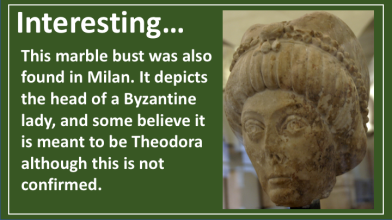
Our only confirmed depiction of Theodora exists in the form of a mosaic portrait in the Church of San Vitale, Ravenna. The portrait, commissioned in the sixth century, is set into the lower walls of the church and faces a similar portrait of her husband across the apse. By analyzing Theodora’s portrait alongside Justinian’s, we are able to gain an understanding of her importance and reception in society. For example, both mosaics show the two dressed in royal garments, Justinian wearing a “diadem, a purple chlamys with gold embroidered tablion, and jewel-encrusted red boots” (Bassett, 2008, p. 49), and Theodora in “nimbus, crown, and purple chlamys” (Bassett, 2008, p. 50). The similarity in colour and style of Theodora’s and Justinian’s clothing shows that she was presented to the public as a woman of high status equal to her husband, despite her low birth. Both figures are also depicted flanked by a retinue of important people, possibly the twelve apostles in Justinian’s case (Andreescu-Treadgold, 1997, p. 4), and a mixture of handmaidens and priests in Theodora’s. Sarah Bassett (2008), in her examination of this detail, draws attention to the fact that Justinian’s mosaic show himself and his retinue all posed similarly, while in Theodora’s mosaic no two figures pose alike (p. 52). This shows Theodora as a woman who broke the mold while Justinian’s portrait may seek to imply that he was backed by many. A similar effect is produced by the background, which is monochromatic in Justinian’s portrait, but detailed and multi-coloured in Theodora’s, again showing uniqueness and vibrancy for Theodora (Andreescu-Treadgold, 1997, p. 1). The vibrant, rich, and kaleidoscopic colours create an image of a majestic, unique, and powerful woman. Cause for skepticism may arise from the fact that the mosaics are located in Italy and date back to the Gothic Wars when Justinian seized control over what was then Vandal territory. The images likely portray an idealized image and were meant to establish dominance over Justinian’s newly conquered territory, however, Theodora’s uniqueness and power in the mosaic should not be ignored as both traits are supported by accounts of her actions and decisions in life.
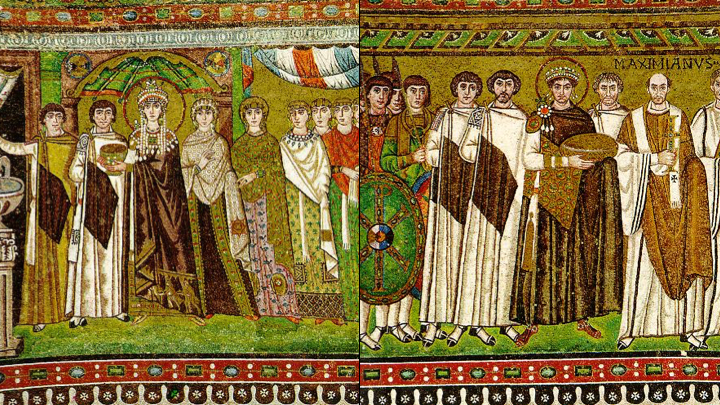
Plot Twist
Procopius’ book Secret History, found hidden in the Vatican library only in the seventeenth century, adds new shades to our image of Theodora and is our main literary account of her life. Procopius lived during Justinian’s reign and documented the Emperor’s success is his book Wars of Justinian. This book describes Theodora in a favourable light, which explains why historians were shocked when they found his secret sequel. The Secret History describes Theodora as greedy, bloodthirsty and promiscuous (Korte, 2005, p. 112), the complete opposite of the government-sanctioned Wars of Justinian. The inconsistencies between Wars of Justinian and Secret History make untangling the life of the real Theodora difficult. Was she a heroic leader or a tyrant?
Several theories can explain why Procopius would write such contradictory narratives. The most obvious explanation is that Procopius was a writer of propaganda who would no doubt have been persecuted and punished for writing anything that did not reflect Justinian’s opinions. In 532 Justinian exiled a senior court official for insulting Theodora (Potter, 2015, p. 26). To slander his beloved wife would have meant death, and so the Secret History was perhaps Procopius’ effort to provide a more truthful account for future readers. However, David Potter (2015) suggests that the Secret History could have been just as dependent on the expectations of an audience as The Wars of Justinian (p. 3). Secret History could have been written near the end of Justinian’s life as an attempt to appease successors to Justinian’s throne who did not hold him in high regard. There are also many discrepancies and clichés in the Secret History that make its veracity questionable. With this in mind, it is safe to say that neither of Procopius’ works should be taken as the entire truth. The real Theodora is hidden behind Procopius’ personal interests and political alliances, but by reading between the lines of his work we can piece together the patches of truth that form her formidable story.
Early Years
The first years of this story take place in Constantinople and centre around the politically charged entertainment industry of the Hippodrome. The Hippodrome, also called the circus, was an enormous stadium attached to the royal palace (Runciman, 1959, p. 192). It was the centre of Byzantine life, a place where people could watch bear fights and chariot-races, dancers and actors, and where the Emperor delivered speeches to the masses (Runciman, 1959, p. 192). As the Hippodrome was a fixture of Byzantine life, the two factions who ran it, the Blues and the Greens, held enormous political influence (Runciman, 1959, p. 193). Theodora’s mother and father belonged to the Green faction, working as a bear-trainer and an actress (Potter, 2015, p.8). When Theodora’s father died early on in her life, he left her mother without a stable income and the family faced

poverty (Potter, 2015, p. 13). To remedy this, Theodora’s mother brought her young daughters before the 50 000 people who filled the Hippodrome’s seats to appeal for a job for her new husband. The Greens firmly rejected her request, but their rivals, the Blues accepted (Procopius, n.d., p. 63). In this way, Theodora’s loyalties transferred from one faction to its equally strong opponent. She began training to be an actress for the faction at ten years old, and by twelve was performing along with her sister Comito in lewd plays and performances similar to today’s burlesque. Procopius tells us in his Secret History that Theodora was an untalented actress consigned to the chorus, but he contradicts himself when he relates that her most memorable act was a solo performance involving a goose and very little clothing (Procopius, n.d., p. 66). However, Procopius’ accounts of Theodora’s stage life are exaggerated and rely heavily on stereotypes of prostitution, which make these inadvertent claims equally untrustworthy. A more reliable indication of her talent may be her attractiveness to Hecebolus, a senior official in the Roman government who was likely twice her age (Procopius, n.d. p. 66).
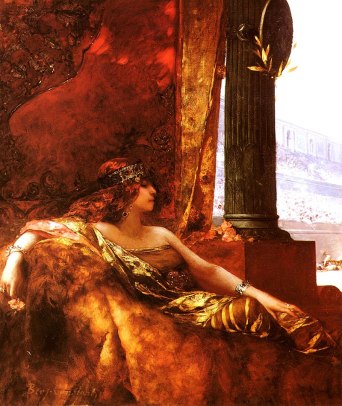
By the time she was sixteen, Theodora had left the stage to become Hecebolus’ concubine. It is debatable whether this relationship was formed out of necessity or love. It was, however, a favourable arrangement for both parties. As an actress, the law prevented Theodora from marrying a man of Hecebolus’ status and their union would, therefore, result in no legal ties (Potter, 2015, p. 56). Her children would also not be seen as legitimate heirs. Hecebolus may have had children from a previous marriage and the promise that he would not have to divide his wealth between any children resulting from his relationship with Theodora might have seemed financially attractive. In terms of finances, the relationship worked well for Theodora too. As Hecebolus’ concubine, Theodora could receive financial support and housing from Hecebolus and expect him to take no other sexual partners. Any children resulting from the union would be hers if the relationship failed (Potter, 2015, p. 56). They lived in North Africa where Theodora gave birth to a daughter, unnamed by Procopius, but likely fathered by Hecebolus (Potter, 2015, p. 27). The relationship was an abusive one with Hecebolus abandoning Theodora to fend for herself as a single mother in Antioch (Potter, 2015, p. 56). But as ill-fated as the relationship may have been, it was a smart one, placing Theodora in the perfect position to meet Justinian. Her four years with Hecebolus had taught her the manners and skills of a high society lady and had provided her with an understanding of the inner workings of the government that would facilitate her influence on Justinian’s later political decisions (Potter, 2015, p. 57).
Meeting Justinian
Procopius asserts that after her split from Hecebolus, Theodora slept her way to Antioch, Syria (Procopius, n.d., p. 67). Some historians dispute this claim, on the grounds that Procopius leaves out some prominent details about this time in Theodora’s life, like her daughter’s existence (Potter, 2015, p. 61), however, there is simply not enough information about her journey to know anything for sure. What we do know is that she arrived in Antioch shortly after parting with Hecebolus and that this is where Theodora met Justinian.
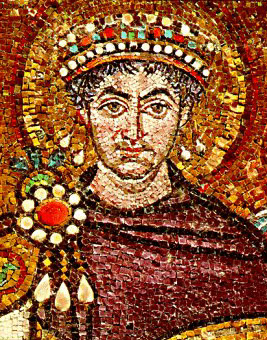
In Antioch, evidence suggests that Theodora renewed her connections with the Blue faction as a spy against the Greens, and pursued an interest in anti-Chalcedonianism, a position on Christianity that was controversial at the time (Potter, 2015, p. 86). At this time, Justinian’s uncle Emperor Justin was on the throne. He was an unlikely emperor, as he was born a peasant. This meant that he lacked the powerful friendships of his competitors. In an effort to gain influence, Justin and his nephew made close alliances with the leaders of the two most influential factions in the Hippodrome, the Greens and the Blues (Potter, 2015, p. 76). Justinian allied himself with the Blues (Procopius, n.d., p. 53) and it is likely that this is where he met Theodora. (Potter, 2015, p. 91). So far, her life had been largely controlled by the factions, as they employed both her parents and herself. Now the factions brought together her relationship. Her strong stance on religion, her talent as proven by her acting career, and her knowledge of the government from her time as Hecebolus’ concubine must have attracted Justinian. His uncle was still emperor, but Justinian was next in line, and he may have seen the qualities of a future empress in Theodora. He elevated Theodora to the status of Patrician (Procopius, n.d., p. 67), as a gesture of his affection, but when it came time for marriage, legal obstacles stood in his way.
Influence as Empress
Marriage
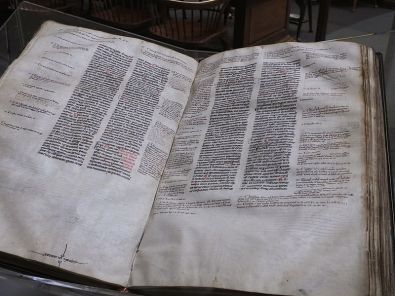
Theodora’s first significant influence in the empire was in inspiring Justinian to change marriage laws (Potter, 2015, p. 91). Prior to 521, a man in a government position could not marry an actress, making Theodora’s and Justinian’s marriage impossible (Potter, 2015, p. 91). It was “Forbidden by the most ancient laws of State,” (Procopius, n.d., p. 70) but Justinian was determined to marry Theodora, which demonstrates the strength and legitimacy of their relationship. He pressed his uncle, still Emperor, to pass a law legalizing his marriage to Theodora. After the death of Empress Euphemia, who did not approve of the relationship, Justin conceded (Procopius, n.d., p. 69). The law was passed in 521 or 522 (Potter, 2015, p. 91). It applied to all marriages within the empire, but in places, it is extremely specific in its descriptions of women now allowed to marry high-status men, descriptions that fit Theodora too well to be coincidental. The law text begins by reasoning that although the profession of actress was still viewed as sinful, the law recognized also redemption and forgiveness, both qualities of Christian doctrine practiced at the time (CJ 5.4.23). If God could forgive the errors of women of disreputable backgrounds, then the law would do the same and allow courtesans to marry freeborn men. The law stated that any woman who abandoned and spurned her former dishonourable profession could petition to the emperor to marry a freeborn man and have the dishonour of her sins forgotten (CJ 5.4.23). The law also stated that daughters – and David Potter (2015), suggests that this was written with Theodora’s illegitimate daughter in mind (p. 93) – would be able to petition to marry above their rank. In this way, both Theodora and her daughter were taken care of. With the law passed, Justinian petitioned to his uncle to marry Theodora and was granted permission (Procopius, n.d., p. 70). The two were married in 525. Two years later Justinian was crowned Emperor and Theodora became Empress. Without question, the law would not have been passed without Theodora’s determination and romantic influence over her Justinian. As inspiration for the law, she affected not only her own life but the lives and reputations of other actresses who had left the stage to pursue stability and love in life. Here is the beginning of the passage from the Codex Justinianus that allowed Theodora to marry Justinian:
Believing that it is a peculiar duty of Imperial beneficence at all times not only to consider the convenience of Our subjects, but also to attempt to supply their needs, We have determined that the errors of women on account of which, through the weakness of their sex, they have chosen to be guilty of dishonorable conduct, should be corrected by a display of proper moderation, and that they should by no means be deprived of the hope of an improvement of status, so that, taking this into consideration, they may the more readily abandon the improvident and disgraceful choice of life which they have made. For We believe that the benevolence of God, and His exceeding clemency towards the human race, should be imitated by Us (as far as Our nature will permit), who is always willing to pardon the sins daily committed by man, accept Our repentance, and bring us to a better condition. Hence, We should seem to be unworthy of pardon Ourselves were We to fail to act in this manner with reference to those subject to Our empire. (CJ 5.4.23)
To read the rest of the Codex Justinianus click Here
Women’s Rights
Theodora continued to better the lives of women like herself by playing an active role in the protection of prostitutes and orphans. John Malalas, a Greek chronicler from Antioch, recounts in his text that Theodora at one point in her reign had all pimps and their victims arrested and brought to her court, where they were ordered to confess how much money they had paid for the girls (Potter, 2015, p. 138). She knew that poor families often sold their daughters into prostitution for a few pieces of gold apiece. Once the pimps had declared their profit, Theodora bought the girls for twice the amount the pimps had initially received and set them free (Potter, 2015, p. 138). She banned the pimps from continuing business and sent the girls home with clean clothes and money (Potter, 2015, p. 138). On another occasion, Theodora took on the orphaned children of a man named Eulios, even though it meant that she and Justinian would be forced to take on his debt (Potter, 2015, p. 137). She raised the girls in the royal apartments so that they would not be forced to turn to prostitution on the streets (Potter, 2015, p. 137). Both instances show incredible compassion in Theodora and a strength of character that allowed her to improve the lives of women in the Byzantine Empire.
The Nika Revolt
In January 532, a riot broke out in the Hippodrome. Nine men had been sentenced to hang in Constantinople for crimes associated with the Green and Blue factions, but two had escaped and were being protected by monks in Saint Lawrence Church (Bury, 1897, p. 118). The crowds in the Hippodrome wanted Justinian to pardon the men – one a member of the Greens, the other of the Blues – and release them (Bury, 1897, p. 118). As the crowd stood before Justinian, they began to shout the word Nika, a word meaning ‘conquer’, that the factions usually volleyed at one another but that they now shouted as one (Bury, 1897, p. 97). It was one of the first times that the factions had worked together and when Justinian refused their request they formed a mob and set fire to the city. The riot went on for five days (Bury, 1897, p. 107). When the riot had died down the mob called for Justinian to step down as emperor and be replaced by Hypatias, nephew of the emperor before Justin (Bury, 1897, p. 97). With the allied fury of the factions against him, Justinian made plans to flee (Bury, 1897, p. 104). But Theodora refused (Mallet, 1887, p. 19). Famously she is quoted as saying:
I believe that flight is not in our best interest… I shall never be separated from this purple, nor shall I live for a single day, if those who encounter me do not call me mistress. If you wish to be saved, my lord, that is not a problem… But consider, if it will benefit you when you have been saved or if safety would be exchanged happily for death. For me the old saying is best, that power is a splendid shroud. (Potter, 2015, p. 152)
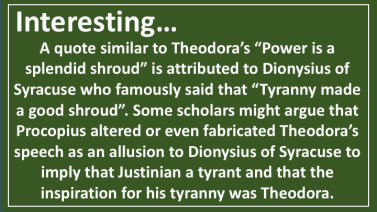
Her words encouraged Justinian to continue to fight. He rallied his most trusted generals around him and had a trusted servant bribe the members of the Blue faction while reminding them that Hypatias favoured the Greens (Bury, 1897, p. 99). This was enough to turn the factions against one another once more, and with their short alliance ended they stood no chance against Justinian’s troops. By the end of the revolt Procopius states that 30 000 people lay dead (Potter, 2015, p. 154), and thanks to Theodora, Justinian continued as Emperor of Rome.
This video by Extra History provides a visual explanation of the Nika Revolt.
Religion
In his history book Byzantine Civilization, Arnold Runciman (1959) explains that “Christianity triumphed in a disillusioned age because it promised a better world to come and provided a mystic escape from the world here and now” (p. 108). Life was tenuous and uncertain in Theodora’s world, so the promise of better circumstances was understandably attractive. There was debate however over how to gain acceptance to the afterlife, centring around the idea of Jesus as human or divine. The Chalcedonians believed that Christ had one person, entirely divine and therefore could not suffer. The Monophysites, a minority group seen by many as heretical, believed that Christ was a synthesis of divine and human and as such capable of suffering. Theodora belonged to the second group, while Justinian sought to combine the two by forcing compromise (Runciman, 1959, p. 36). In belonging to the minority group, Theodora was able to help the Monophysites face their stronger opponents. She maintained friendships with proponents of the anti-Chalcedonian movement such as a man named Mare and a monk named Zoora, both men who were initially met with disapproval from Justinian (Potter, 2015, p. 171). By supporting these men Theodora secured for them a place in the palace. They were allowed to continue holding Monophysite assemblies even though these had been recently banned (Potter, 2015, p. 172). Theodora’s influence continued to put Monophysite men in power throughout her reign as Empress, even though Justinian leaned more toward Chalcedonianism (Potter, 2015, p. 173). Although her efforts to put an end to Chalcedonianism eventually failed, she was able to keep her Monophysite friends safe and promote her religious beliefs (Runciman, 2015, p. 37). This shows that Theodora’s influence as empress did not rely on her husband’s opinions alone. She voiced her own beliefs with confidence and courage, securing for herself a place as a saint in the Orthodox Church along with Justinian.
Death

Theodora’s enormously influential life and reign came to an end on June 28, 548 AD. She had survived the pestilence of the bubonic plague that had ravaged the city for years (Potter, 2015, p. 197) but succumbed to what may have been cancer (Potter, 2015, p. 202). In the last years of her life, she remained a powerful presence in the royal court by arranging the marriages of her loved ones, marriages that would play a role in the rule of the empire after her death (Procopius, n.d., p. 46). Theodora’s niece Sophia became Empress after Justinian’s death. Her involvement in financial and economic matters made her arguably the most politically active empress of her age, but she might never have become empress at all if Theodora had not arranged her marriage to Justin II, Justinian’s nephew and heir (Potter, 2015, p. 202).
Such influence was uncommon for a woman in sixth century Rome and is especially impressive considering Theodora’s unusual beginning. It shows that her accomplishments were entirely her own, the result of her quick wit, keen social skills, strong moral beliefs, and shrewd political acumen. Her story may be viewed today as a Cinderella story, but it is more fittingly the story of a woman who never needed a fairy godmother to gain influence, the story of a self-made woman in antiquity.
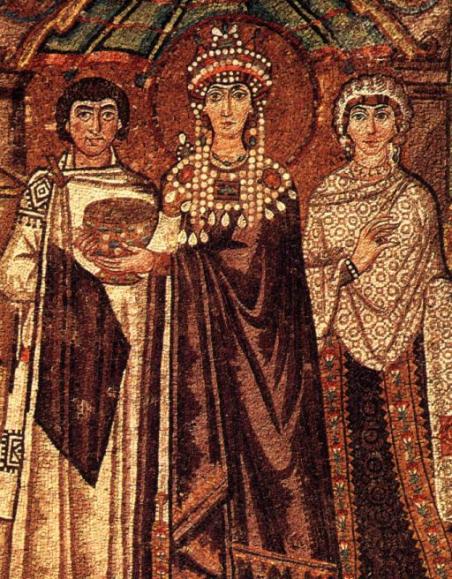
References
(A.D. 547) Theodora and Her Court. Basilica of San Vitale, Ravenna.
Andreescu-Treadgold, I., & Treadgold, W. (1997). Procopius and the Imperial Panels of S. Vitale. The Art Bulletin, 79(4), 708-723.
Bassett, S. (2008). Style and Meaning in the Imperial Panels at San Vitale. Artibus Et Historiae, 29(57), 49-57.
Bury, J. (1897). The Nika Riot. The Journal of Hellenic Studies,17, 92-119.
Cartwright M. (28 November 2017). The Hippodrome of Constantinople. Retrieved from https://www.ancient.eu
Justin I. (529 AD). Codex Justinianus [pdf]. Retrieved from https://droitromain.univ-grenoble-alpes.fr/Anglica/CJ5_Scott.htm#4
Korte, N. E. (2005) Procopius’ Portrayal of Theodora in the Secret History. Hirundo: The McGill Journal of Classical Studies, Volume III
Nicol, D. M. (1994). The Byzantine Lady: Ten Portraits. New York: Press Syndicate of the University of Cambridge.
Potter, D. (2015). Theodora: Actress, Empress, Saint. New York: Oxford University Press.
Procopius (n.d.). Secret History [PDF]. Retrieved from http://www.fulltextarchive.com/pdfs/The-Secret-History-of-the-Court-of-Justinian.pdf
Runciman, S. (1959). Byzantine Civilization. London: Lund Humphries.
Interesting article. Well done Katie.
LikeLike